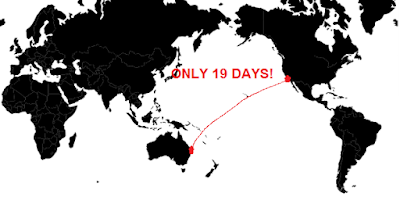According to the experts, when one moves abroad they
go through four phases of adaptation to the culture:
1. Elation-
or the honeymoon phase when “Everything here is so different and exciting!”
2. Resistance-
when expats compare the new environment to what they are accustomed to at home:
“XYZ is better back home than here.”
3. Transformation-
about nine months after moving abroad, expats begin to see the positive side of
“all those differences”, and
4. Integration-
when the new location becomes “home”.
Having lived overseas a bit, my transition
to life in Australia has been pretty easy.
I am experiencing resistance to only one aspect of Australian life:
ADJECTIVES. You heard me right…
ADJECTIVES. Actually, just one adjective
in particular.
The first week I arrived in OZ, The Great Australian Spelling Bee was one of the top programs on
television. I kid you not. Being a nerd, I mean, a professor, I thought
it my duty to diligently tune in to channel 10 each evening. I quickly learned we don’t fly in airplanes
in OZ, we fly in aeroplanes. And it’s
not Aitch-R (HR), it’s HAITCH-R. (If you don’t know what I’m talking about, go
ahead and say your nice, American “H”.
Now, make the “hhhhhhhh” sound and immediately tack the letter “H” onto
the end. If you still can’t figure it out, watch this, and try not to feel too
inadequate.) On principle, I still fly
in airplanes and file my employment paperwork at Aitch-R.
If you have ever participated in a Spelling Bee- I
did, in the 7th grade, and no, I did not win- you know that a
contestant may ask for a definition, or that the word be used in a sentence. Enter the dictionary. Australia does not use Webster’s, as is most
common in the U.S. The official
Australian dictionary is the Macquarie Dictionary. I recently became well acquainted with the
Macquarie Dictionary when I felt the need to look up a word which is grossly
overused Down Under: beautiful.
My first day on campus a colleague introduced me to
her graduate student, who took me on a little tour. When he returned me to his professor’s office,
she asked me, “Did you like Student X?
Isn’t he just beautiful?” A
puzzled look on my face, I replied, “Uhhhhhhhhhhh… what?” I thought perhaps this professor was either
crazy, or maybe she was just an overly emotional type. She responded, “He’s such a great
person. He’s really beautiful.” I did not respond.
Not long after meeting the beautiful graduate
student I was in the lunchroom at work and was offered a strawberry from a
colleague. “Here Kelly, have some
strawberries. I grew them myself. They are beautiful.” They did look quite nice, and they tasted
good. Of course, I still couldn’t figure
out whether designating the strawberry as beautiful was intended to refer to
the outward appearance, or the deliciousness.
I’m convinced that over the last six months I’ve
heard the word beautiful used more times than in the previous 35 years. Meet a new neighbour? The neighbour is beautiful. The park down the road? Beautiful.
How was the night you spent in jail? That’s right!
Beautiful.
But the tipping point in my newfound hatred of this
word came recently when my roommate returned from the pool.
Kelly: “Hey roomie.
How was the pool?”
Roomie: “Ah!
It was beautiful!”
Kelly: “Well, was the water cold? Or was it comfortable? Were a lot of people there? What about the chlorine? I don’t like swimming in pools that are over
chlorinated, so, how was it?”
Roomie: “It was beautiful!”
Kelly: “WHAT THE HELL DOES THAT MEAN?!?!?!”
Ok, I didn’t really say that, but I sure wanted to.
Apparently, there are no other adjectives in
Australian English which convey a positive sentiment. It’s either beautiful, or bust. The problem is that the word is so overused here
that it is completely ruined for me. I
was telling a friend recently that if a man ever told me I was beautiful I
would be forced to dump him immediately because quite frankly, I wouldn’t
believe him. “I’m beautiful? Well, the other day you called the garbage
can beautiful. So, by default you
basically just called me garbage. Is
that what you are saying?”
After hearing about the beautiful pool I was forced
to spend some time with Macquarie’s to see if beautiful has a different meaning
here. And lo and behold, it does. Not only does it describe visual appeal, it
can also be used to mean anything pleasant.
In fact Macquarie’s used the example: a beautiful meal.
But, I don’t care if it is in the dictionary. I will resist using beautiful until my last
dying breath. And I never thought I
would say this, but, please don’t ever call me beautiful.





























